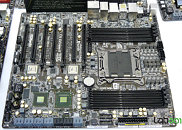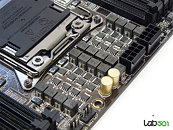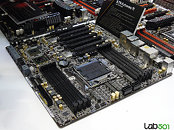- Joined
- Oct 9, 2007
- Messages
- 47,538 (7.47/day)
- Location
- Hyderabad, India
| System Name | RBMK-1000 |
|---|---|
| Processor | AMD Ryzen 7 5700G |
| Motherboard | ASUS ROG Strix B450-E Gaming |
| Cooling | DeepCool Gammax L240 V2 |
| Memory | 2x 8GB G.Skill Sniper X |
| Video Card(s) | Palit GeForce RTX 2080 SUPER GameRock |
| Storage | Western Digital Black NVMe 512GB |
| Display(s) | BenQ 1440p 60 Hz 27-inch |
| Case | Corsair Carbide 100R |
| Audio Device(s) | ASUS SupremeFX S1220A |
| Power Supply | Cooler Master MWE Gold 650W |
| Mouse | ASUS ROG Strix Impact |
| Keyboard | Gamdias Hermes E2 |
| Software | Windows 11 Pro |
A serious player in the PC motherboard industry, the world's 3rd biggest (in terms of volumes) at that, ASRock is one brand that has accumulated the engineering potential to make anything. It's far from finished with its LGA2011 motherboard lineup, and made sure visitors at its CeBIT booth had their jaws on the floor. Enter, the ASRock X79 Extreme11. This motherboard is designed for not just extremely-overclocked PCs, but battlestations holding their own huge storage arrays. This monster is built in the EATX form-factor.
The LGA2011 socket is powered by a 16+2 phase DigiPower VRM, which draws power from two 8-pin EPS connectors. It is wired to eight DDR3 DIMM slots, supporting up to 64 GB of quad-channel DDR3 memory with speeds of over DDR3-2400 MHz by overclocking. The memory areas are powered by 4+4 phase VRM. Apart from the 24-pin ATX connector, and the two EPS connectors, the board also draws power from two 4-pin Molex connectors. The board makes use of Japanese-made solid-state capacitors almost throughout.



How the ASRock X79 Extreme11 marshals the 32 PCI-Express 3.0 lanes from the LGA2011 CPU is particularly interesting. Each of the two PCI-Express 3.0 x16 links from the CPU appear to pass to a bridge chip (PLX PEX8747), which takes in a Gen 3.0 x16 link to give out two Gen 3.0 x16 links. The four PCI-Express 3.0 x16 links thus generated, are distributed among the seven PCI-Express x16 long slots, and go on to drive other onboard devices. NVIDIA 4-way SLI and AMD 4-way CrossFireX are naturally supported.
Speaking of onboard devices, south of the X79 PCH, you will notice a big LSI-branded chip. That's the LSI SAS2308 storage processor, which gives out eight SAS/SATA 6 Gb/s ports, complete with support for several complex RAID modes. What makes this chip bleeding-edge is its support for PCI-Express 3.0. All eight SAS ports from the SAS2308 are wired out as internal ports, next to two SATA 6 Gb/s and four SATA 3 Gb/s ports from the Intel X79 PCH.
Moving on, the sound subsystem on the X79 Extreme11 is care of Creative Sound Core3D audio processor, with 8 channels output, and support for THX TruStudio Pro. There are two gigabit Ethernet interfaces, driven by Broadcom-made controllers. There are a total of eight USB 3.0 ports (four on the rear-panel, four via headers). A variety of ASRock-exclusive features are found, including UEFI BIOS with System Browser, XFastLAN, XFastUSB. The heatsinks have not taken shape, but the one over the PCH is sure to feature a fan.
View at TechPowerUp Main Site
The LGA2011 socket is powered by a 16+2 phase DigiPower VRM, which draws power from two 8-pin EPS connectors. It is wired to eight DDR3 DIMM slots, supporting up to 64 GB of quad-channel DDR3 memory with speeds of over DDR3-2400 MHz by overclocking. The memory areas are powered by 4+4 phase VRM. Apart from the 24-pin ATX connector, and the two EPS connectors, the board also draws power from two 4-pin Molex connectors. The board makes use of Japanese-made solid-state capacitors almost throughout.



How the ASRock X79 Extreme11 marshals the 32 PCI-Express 3.0 lanes from the LGA2011 CPU is particularly interesting. Each of the two PCI-Express 3.0 x16 links from the CPU appear to pass to a bridge chip (PLX PEX8747), which takes in a Gen 3.0 x16 link to give out two Gen 3.0 x16 links. The four PCI-Express 3.0 x16 links thus generated, are distributed among the seven PCI-Express x16 long slots, and go on to drive other onboard devices. NVIDIA 4-way SLI and AMD 4-way CrossFireX are naturally supported.
Speaking of onboard devices, south of the X79 PCH, you will notice a big LSI-branded chip. That's the LSI SAS2308 storage processor, which gives out eight SAS/SATA 6 Gb/s ports, complete with support for several complex RAID modes. What makes this chip bleeding-edge is its support for PCI-Express 3.0. All eight SAS ports from the SAS2308 are wired out as internal ports, next to two SATA 6 Gb/s and four SATA 3 Gb/s ports from the Intel X79 PCH.
Moving on, the sound subsystem on the X79 Extreme11 is care of Creative Sound Core3D audio processor, with 8 channels output, and support for THX TruStudio Pro. There are two gigabit Ethernet interfaces, driven by Broadcom-made controllers. There are a total of eight USB 3.0 ports (four on the rear-panel, four via headers). A variety of ASRock-exclusive features are found, including UEFI BIOS with System Browser, XFastLAN, XFastUSB. The heatsinks have not taken shape, but the one over the PCH is sure to feature a fan.
View at TechPowerUp Main Site
Last edited:




 .............................
.............................






 )
)